Official correspondence following a death in the Great War – Private Cornelius Hayes, Cheshire Regiment
- Home
- World War I Articles
- Official correspondence following a death in the Great War – Private Cornelius Hayes, Cheshire Regiment
The improved availability of online records has made tracing of the life and service of a Great War soldier relatively easy compared to the situation only a few years ago. The records available from free and commercial websites include
- Medal Roll Index Cards, for every soldier who served overseas.
- The Campaign Medal and Silver War Badge Rolls for which there will be one or more entries for each man, depending on when he first went overseas.
- Service Records might be among those that survived the 1940s fire and, if so, can provide a wealth of information. However, for approximately 70% of soldiers, these have been lost.
For a soldier who died during the war, there are additional records available. Typically, these include:
- a pension record card for his widow (and/or other dependants),
- an entry in the Ledger of Soldiers' Effects,
- a record of his will,
- a death certificate,
- his burial records (as preserved by the Commonwealth War Graves Commission).
All of these records reflect interaction with the family of the deceased. However, in most cases, the correspondence generated by this process will have been lost. Cornelius Hayes, 6th battalion Cheshire Regiment, died of wounds on 6th May 1917 in the Ypres salient. When his widow died in 1953, an old handbag containing correspondence from various official bodies following her husband’s death was among her effects. They are presented here to illustrate a fuller picture of the actions and decisions reflected in some of the official records.
Family Background
Cornelius Hayes was born in 1877. His father (also Cornelius) was an Irish immigrant from Limerick, where the family had a tradition of being hat-makers. Cornelius senior (or “Old Con”) was attracted to Stockport in the late 1860s as a centre for hat making. There he met and married Margaret Smith, herself from Stockport of Irish parents. They had a family of five girls and two boys of whom Cornelius (“Young Con”) was the eldest son. Young Cornelius and his brother Joseph followed their father to become journeyman hatters. Young Cornelius married Mary Rigby in 1900. However, she died in child-birth the following year (the baby Mary survived – she is this author’s grandmother). In 1904 Cornelius re-married, to Florence Holroyd, and they had a further four children: Margaret, Thomas, Joseph and Catherine. The family were very active with Stockport Lads Club in the years before 1914 (Figure 1). Soon after the outbreak of the Great War, Cornelius, and later his brother Joseph, joined the local territorial unit, 6th Battalion Cheshire Regiment.
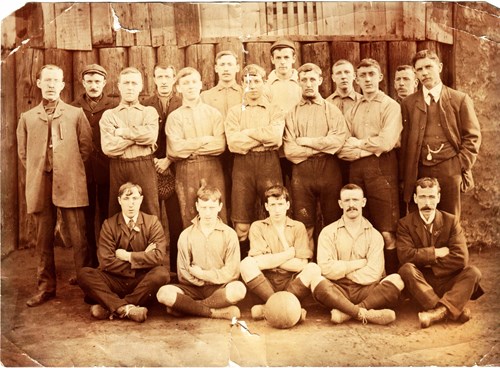
War Service
Cornelius enlisted in the 6th Battalion Cheshire Regiment as 2473 (later 265690) Private Cornelius Hayes on 19th September 1914. He was 37 years old. Cornelius’ motive for joining was not patriotic fervour. Family stories say he was finding it difficult to keep in work due to trade union activities. Being a journeyman hatter, he had no guaranteed work from one day to another. [However, contradicting this, following the war, he was included on the war memorial of Battersby’s Hat Factory.]
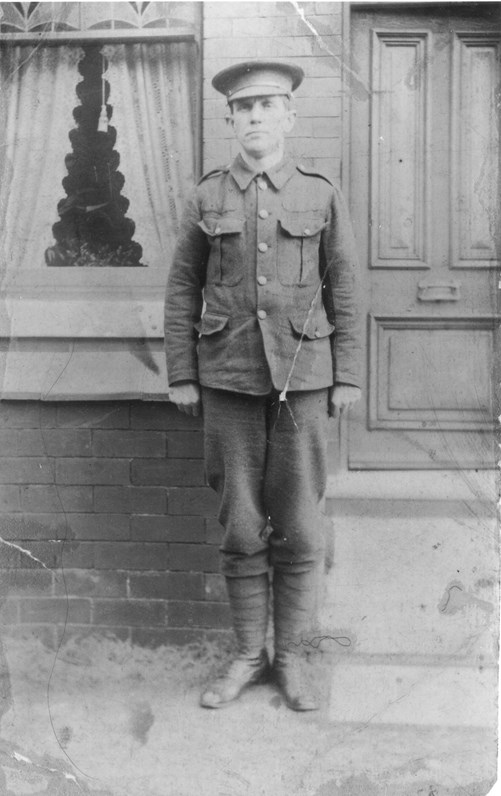
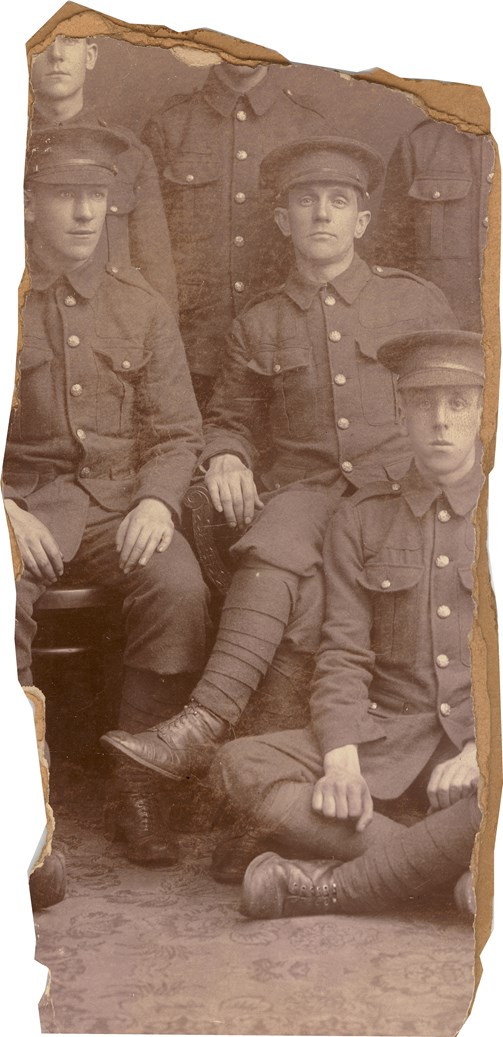
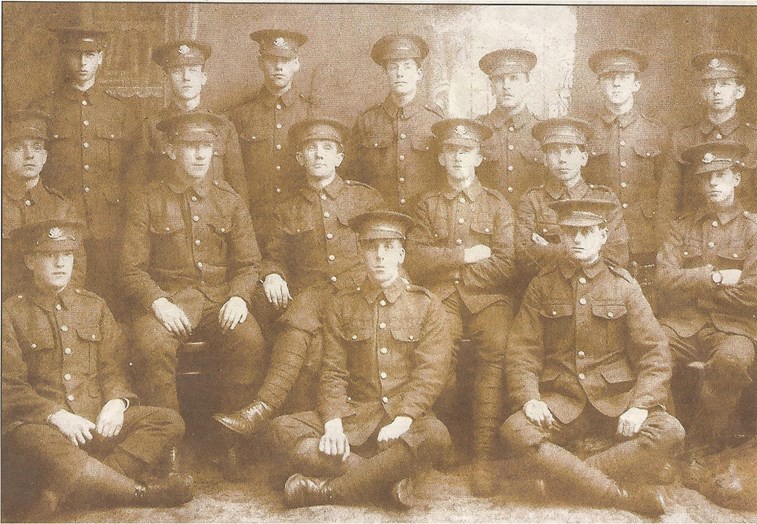
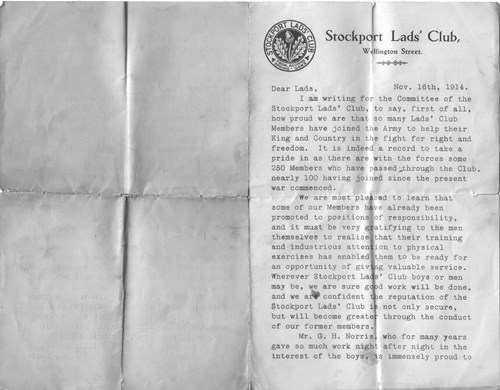
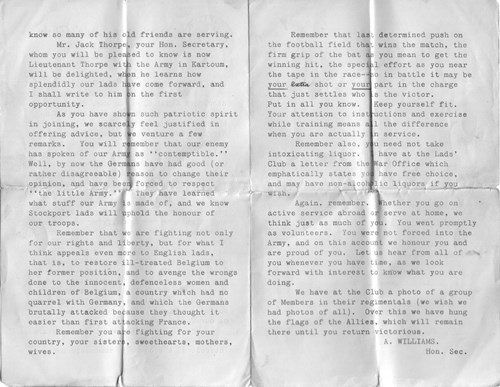
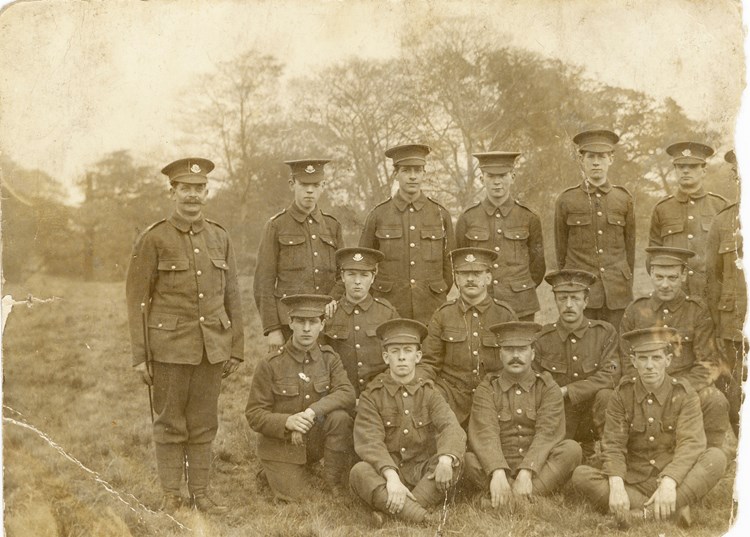
While Cornelius was training with the reserves, first in Stockport then in Northampton and Cambridge, the established 6th Battalion Cheshire regiment were deployed to France on 10th November 1914. They experienced front line service first in early December, companies taking turns in the trenches at Wulverghem, south of Ypres. On Christmas Day, they took part in the truce with the Germans including an informal game of football. They were still in that area when Cornelius Hayes arrived in France at the end of January.
Cornelius disembarked in France on 26th January 1915. He therefore was probably among the draft that, according to the War Diary, joined the battalion in the field on 29th January. The battalion at this time was part of the 15th Infantry Brigade in the 5th Division of the BEF. The battalion alternated between 9 and 10-day stints in the front line trenches at Wulverghem and reserve at St Jans-Capelle and Dranoutre for the month of February. In March they were assigned to GHQ at St Omer. For the rest of 1915 the battalion was split up, working on lines of communication from bases in Le Havre, Rouen, Dieppe, Boulogne and Abbeville. Cornelius was in hospital in Boulogne in July and sent postcards from there which suggests he may have been with C Company which was based there.
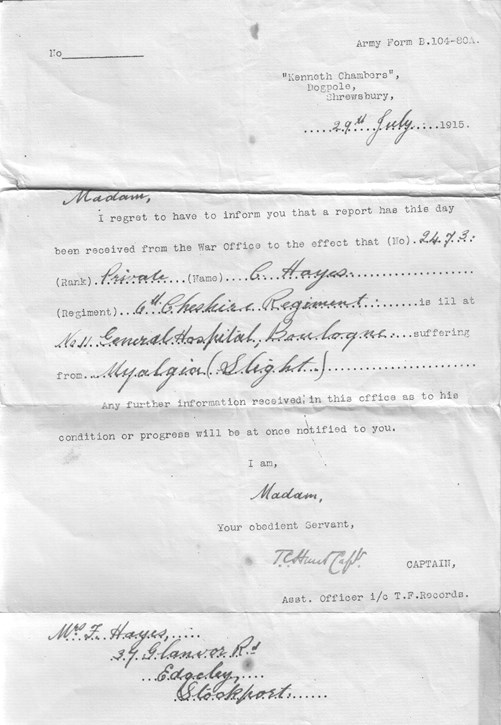
In January 1916 the battalion joined the 7th Division and went into the front line again at Fricourt. At the end of February they were moved to the 39th Division. They saw front line service at Festubert and Givenchy, taking part in a major raid on Red Dragon Crater (19th July). In August they were moved down to the Beaumont Hamel/Thiepval sector and were involved in the capture of the Schwaben Redoubt (14th October) and of St Pierre Divion (13th November), the last major action on the Somme in 1916. A move to the Ypres salient followed and, in the first half of 1917, front-line service at Boesinghe, Zillebeke and Weiltje.
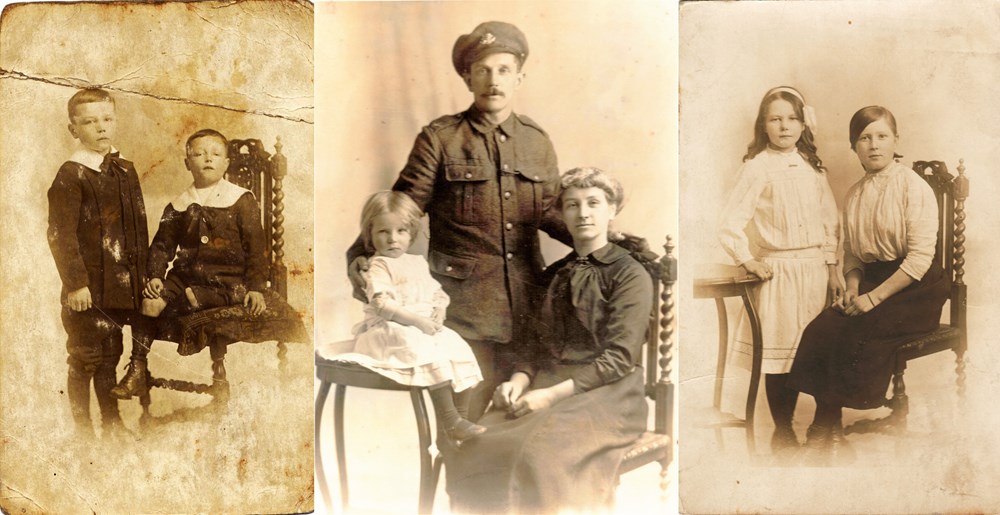
On 6th May 1917, Cornelius Hayes died of wounds while the battalion was in the front line in Hilltop sector, NE of Ypres. He is presumably the Other Rank referred to in the Battalion War Diary as taken to hospital on that date. However, it is possible that he was wounded earlier in the week (another OR wounded is reported on 3rd May). Family stories say that his brother Joseph was present with him at death. Cornelius is buried in Lijssenthoek Military Cemetery, which was adjacent to Remy Siding, at the time the location for the 17th Casualty Clearing Station. There is no mention of him in their war diary although three other deaths are mentioned by name that week. It can perhaps be assumed that Cornelius had already died en-route and so was not admitted to the hospital. Burials occurred daily but he is buried with others that died on 8th May (and this was the date first reported in error as his date of death) so perhaps it took his body two days to reach Lijssenthoek. Cornelius Hayes was buried on 8th May 1917 in Section VIII, Row A, grave 40.
Following Cornelius’ death, the battalion took part in the first day of the battle of 3rd Ypres on 31st July, attacking in the second wave from the same trenches where Cornelius had been wounded. The War Diary for 31st July ends with “Casualties – 3 officers killed, 13 Officers wounded, 500 OR (approx.) killed, wounded and missing.”
The surviving correspondence with Cornelius’ widow was from various government bodies. During service, one of several regional record offices dealt with most administrative matters. Each of these was responsible for record keeping and enquiries concerning soldiers and with the payment of family separation allowances. Each regional office generally dealt with five or six regiments from the same region. The Cheshire Regiment was served by the office in Shrewsbury. Following a death, the same office dealt with preliminary issues (notification of death, burial details, continuation of separation allowance) while the Ministry of Pensions (Widows and Dependents branch) in London dealt with the claim to a pension. Details of the soldier’s will and the consequent distribution of back pay, allowances and gratuities to the beneficiaries were the responsibility of the War Office.
Pension Record Card
The pension record card for Cornelius Hayes (Figure 9) is one of those in the series for Soldiers Died (whose next of kin claimed a pension). A corresponding ledger entry has yet to be found – the lack of a ledger reference on the card probably means a ledger does not exist. The entries on the card match the surviving correspondence with his widow regarding the pension she eventually received.
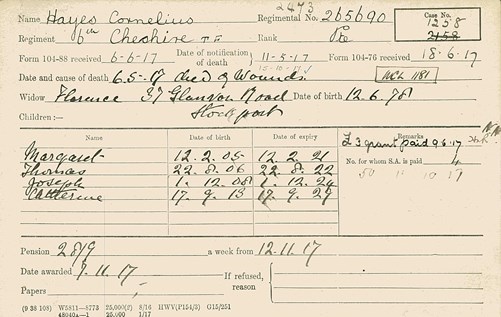
Notification of the death of Cornelius Hayes was sent on Form B 104-82B to his wife Florence by the Territorial Force Record Office in Shrewsbury on 11 May (Figure 10). As his brother was present with the battalion, it is probable that the family knew of his death prior to receiving this official notification. The notification erroneously gave the date-of-death as 8th May. This was subsequently corrected in a follow-up note sent on 2nd June (Figure 12) at which point someone in the family has corrected the letter. This was followed on 14th May by Form W 3030 from the Territorial County Association indicating that Florence’s separation allowance would continue as normal for a further 26 weeks (Figure 11).
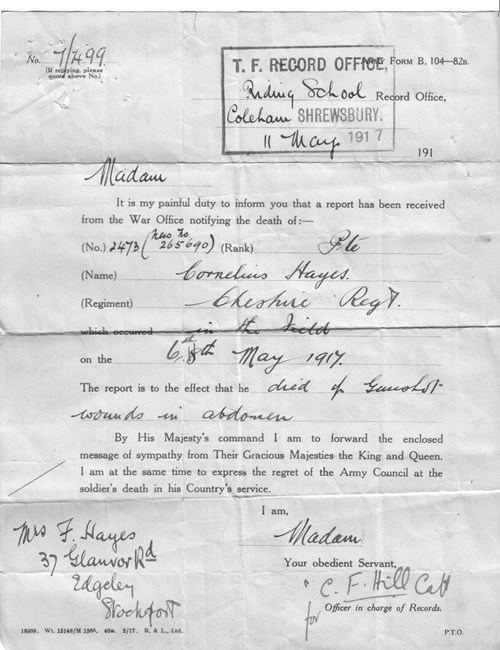
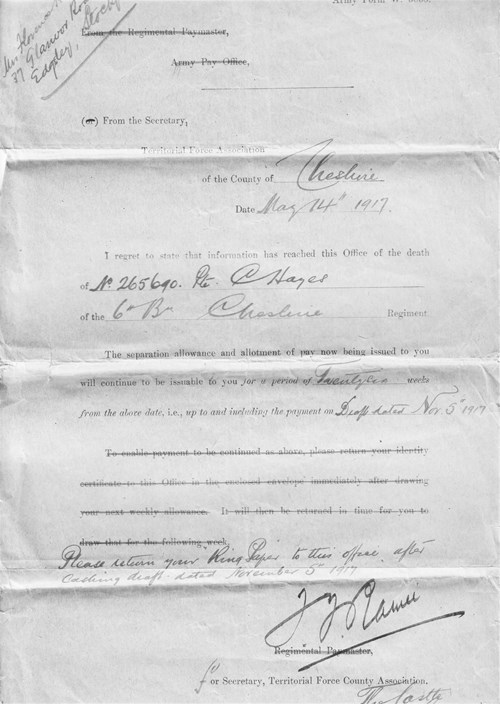
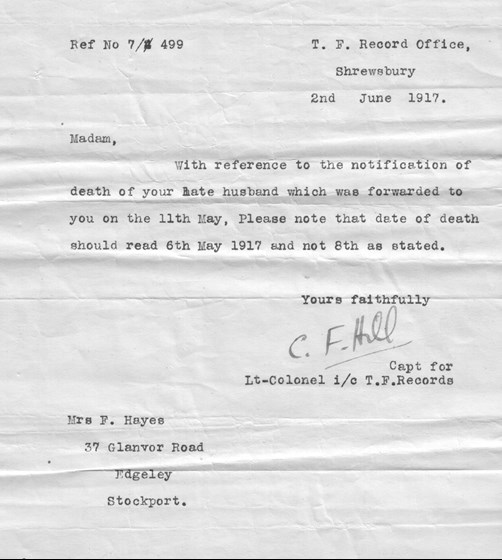
The Pension Record Card (Figure 9) would have been opened when Form B 104-88 (Death notification of married man sent from Territorial Force Record Office to the War Office – not shown here) was received by the War Office on 6th June. This gave details of the soldier and his date of death. (Notice how most of the first three lines on the card are in the same hand). A case number was allocated at this point (although this has been entered in error and subsequently corrected). In the meantime, on 2nd June, the TF Record Office had sent form B 104-76 (Declaration to be made by the widow of soldier in support of claim to pension for herself and children) to the widow that required her to give details of herself and children enclosing birth and marriage certificates (Figure 13). These were forwarded to the Widows and Dependents Office of the Ministry of Pensions, the pension card indicating they were received there on 18th June. The salient details were transcribed on to the record card including the date when each child reached 16-years-old and so became ineligible. The eldest daughter Mary had reached her sixteenth birthday in February 1917 so was not included as a dependent.
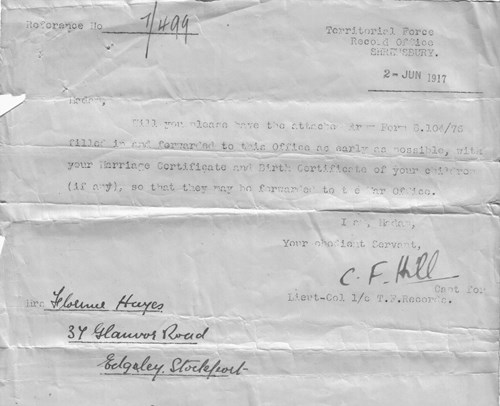
The certificates were returned to the family on 6th July (Figure 14 and Figure 15). “WCL1181” is entered on the pension card and this appears to be the widow’s identity number. Under the remarks section on the card is noted that a £3 grant was paid on 9th June. A hand-written letter was sent with this amount to the widow on 11th June (Figure 16). An undated follow-up letter added a further £2 gratuity (Figure 17). An additional note under remarks dated 1/10/17 might refer to this addition.
The pension was awarded from 12 November 1917 at a rate of 28s/9d (£1.43) per week. A letter to this effect was sent on 26th October (Figure 18) with an explanation of how it was calculated. In the following May, this was increased for each child, bringing the total to 33s/9d (£1.68) per week. This later increase is not indicated on the pension card.
There are some other as yet unexplained marks on the index card. Under date of notification of death, an additional date of 15/10/17 has been added. This might refer to correspondence regarding the burial location (Figure 40). Next to the remark about the gratuity is possibly someone’s initials (StnR) plus “N.N.” which could possibly be short for “Noted for Novel", an unexplained note on many cards.
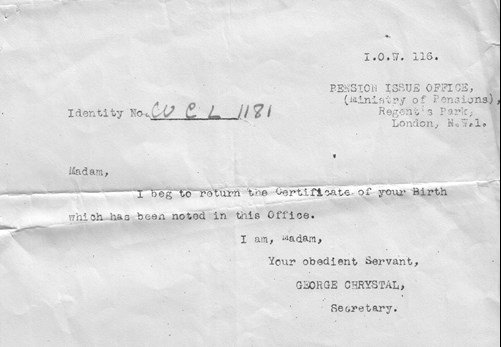
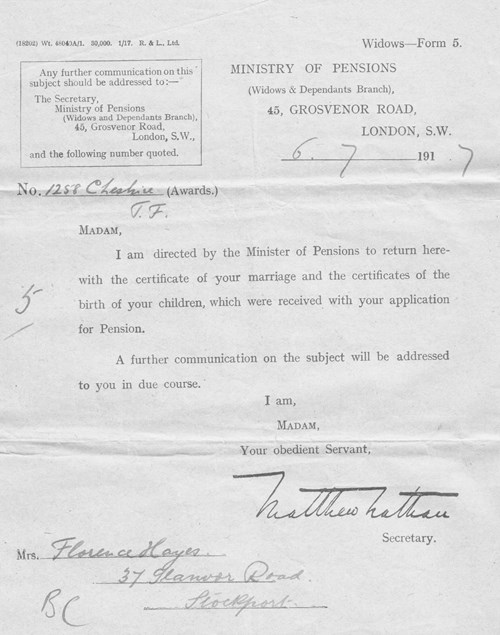
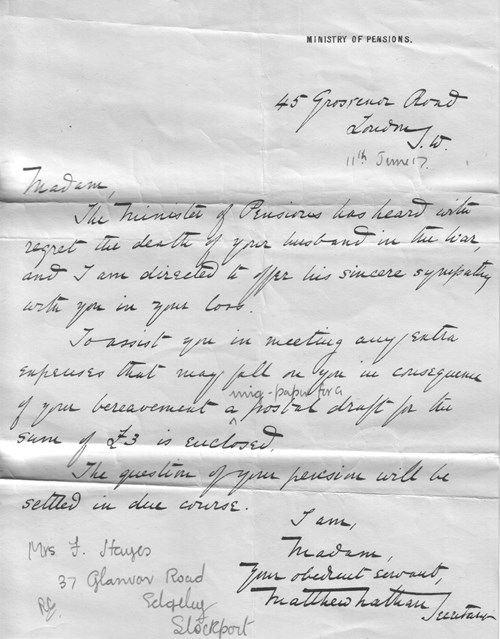
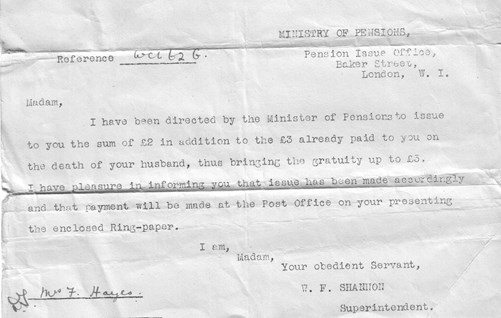
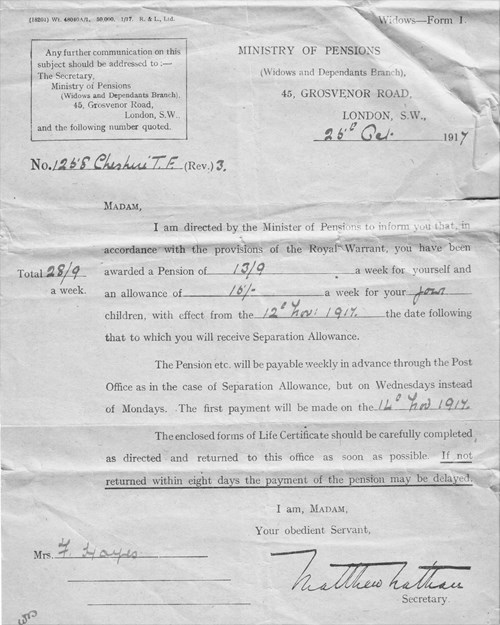
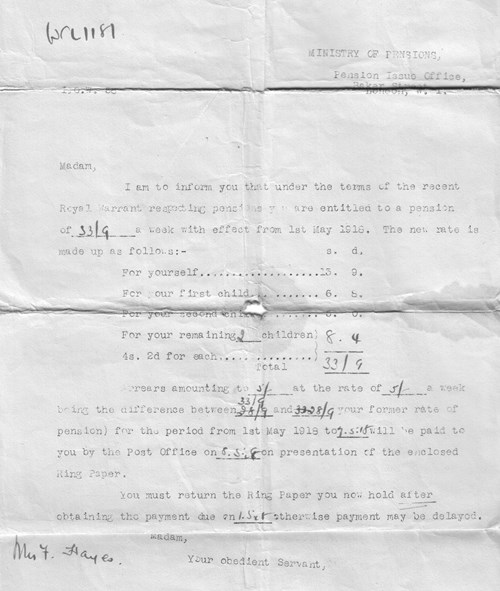
Register of Soldiers’ Effects
There are generally two payments to next-of-kin of the deceased shown in the Register of Soldier’s Effects (Figure 20). In our case, the first entry hides a protracted correspondence between War Office and widow concerning the correct amount owed. A payment representing a gratuity, outstanding pay and allowances of £4 9s 4d was notified by the War Office on Effects Form 45G to his widow on 18th August 1917 (Figure 21). It appears she received a payment from the Paymaster’s Office within the few days promised but it was for a different amount. Therefore, she wrote to the paymaster on 6th September with an enquiry, receiving an acknowledgement on 25th (Figure 22). A follow-up letter (Figure 23) on 29th October stated the amount she was paid as £4 19s 4d. She queried this again on 31st October and finally a correct account was sent on 8th November (Figure 24). None of this correspondence is reflected in the Effects Register; it seems to be due to subsequent clerical error introduced by the War Office.
![]()

Following the armistice, each soldier who served overseas, or his next-of-kin, was due a war gratuity, the size of which reflected his time served and rank achieved. The Effects Register shows that Army Form W5070 was sent on 28th June 1919. This form was to obtain up-to-date details of surviving next-of-kin. The register indicates that £12 was sent to his widow on 14th November, which would have been calculated based on his service between September 1914 and his death (minus the previously paid gratuity).
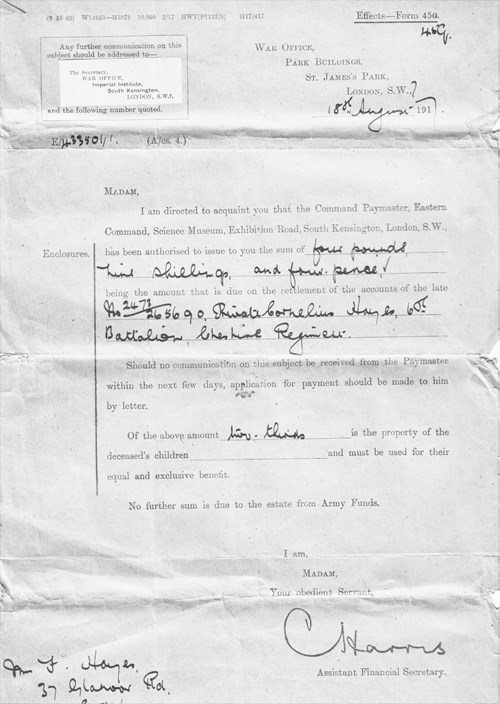
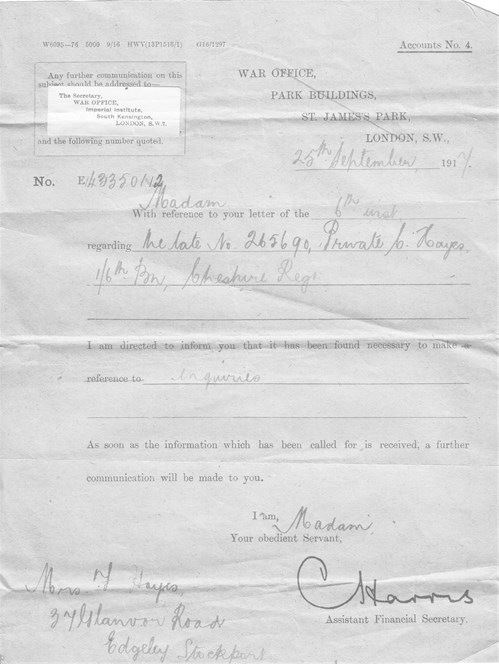
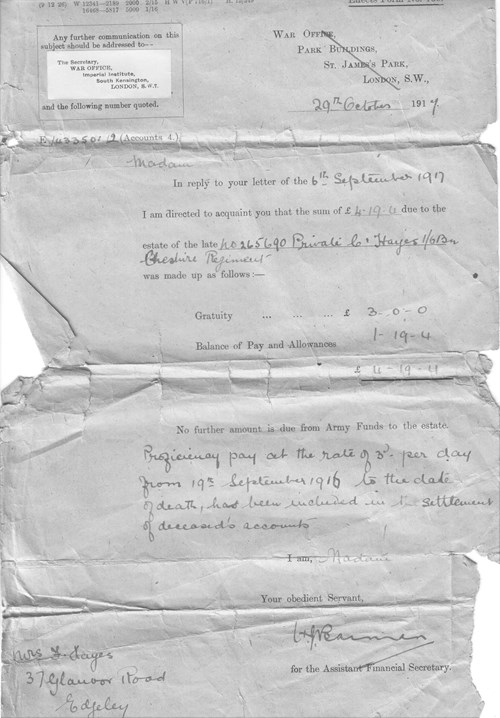
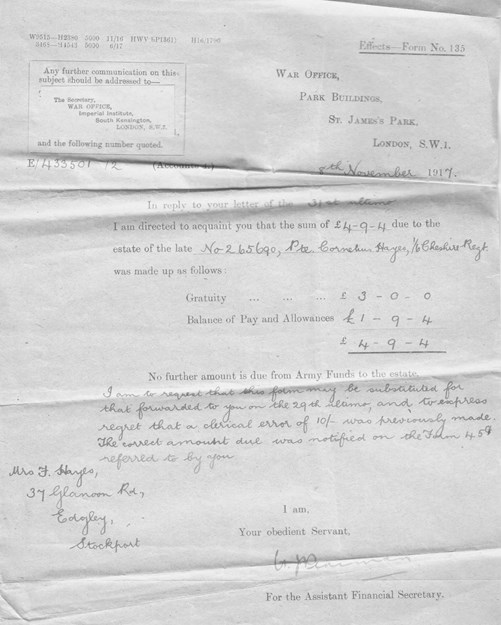
Soldiers’ Wills
Great War soldiers’ wills are available on-line from the government probate office (https://probatesearch.service.gov.uk/#soldiers). As in most cases, Cornelius’ will is as written by him in his 'Soldier’s Pay Book' and leaves everything to his wife (Figure 25). Following his death the page was removed from the pay book and sent to The War Office who forwarded a typewritten copy to his widow on 27th March 1918 (Figure 27). The copy (Figure 26) preserves the spacing, corrections and spelling mistakes of the original faithfully. This was used in association with the returned form 5070 to award the £12 gratuity listed in the Effects Register to his widow in November 1919 (Figure 28).
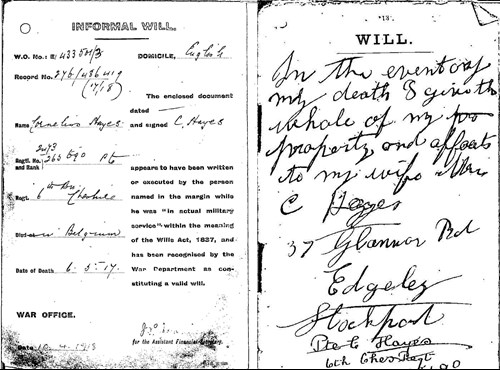
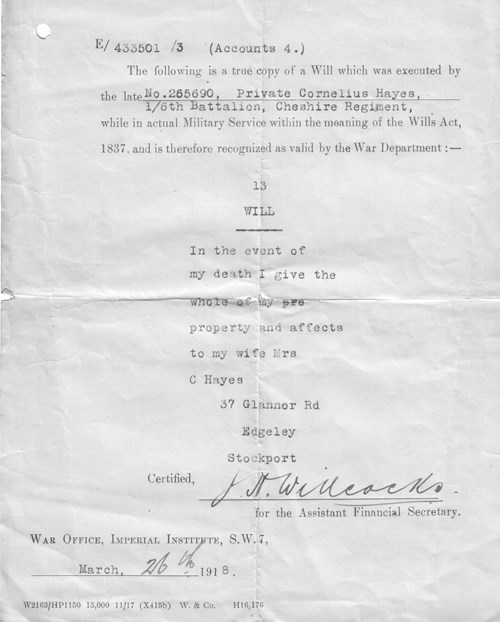
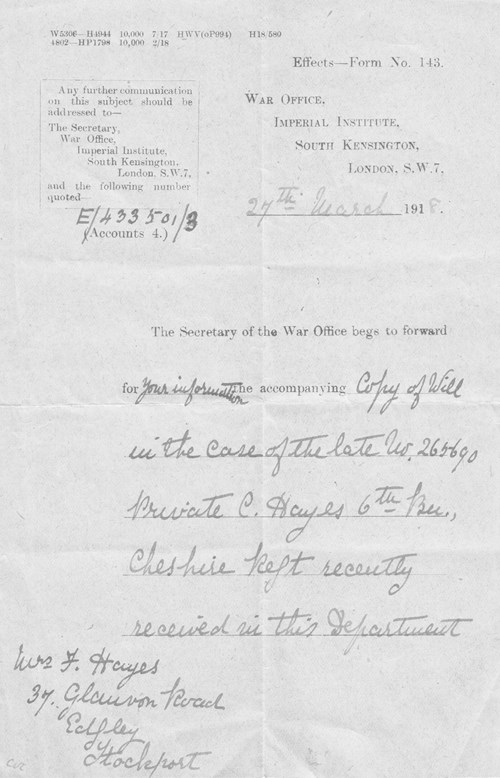
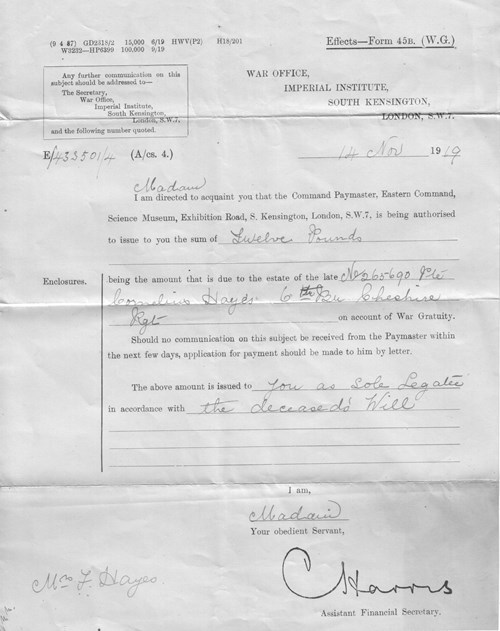
Medal Index Card and Rolls
The issuing of campaign medals to the next-of-kin of the deceased was carried out by the appropriate regional record office, in this case, in Shrewsbury. The Medal Index Card (Figure 29) gives the references to the two medal rolls. The 14/15 Star roll for the Cheshire Regiment (Figure 30) was compiled in February 1920. The letter accompanying the medal is dated 26th August 1920 (Figure 31). The bottom of the letter contained a form to be returned to acknowledge receipt. Figure 32 shows an example for another soldier that can be found with the corresponding service record. The British War/Victory medals followed in April 1922 (Figure 34). A similar acknowledgement form to that for the 14/15 Star had to be returned.
![Figure 29. Medal Index Card [NA via Ancestry] (reverse is blank)](/media/6019/figure29.jpg?width=502&height=336)
![Figure 30. 14/15 Star medal roll [NA via Ancestry]](/media/6020/figure30.jpg?width=501&height=300)
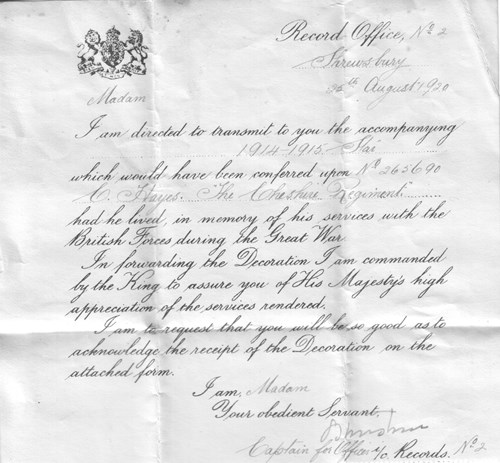
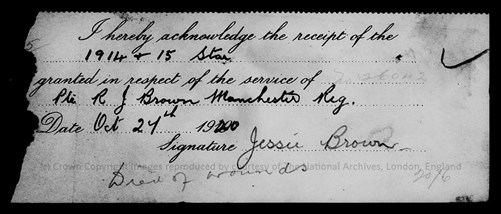
![Figure 33. Victory & British War Medal roll [NA via Ancestry]](/media/6023/figure33.jpg?width=501&height=240)
![Victory & British War Medal roll [NA via Ancestry]](/media/6024/figure34a.jpg?width=500&height=280)
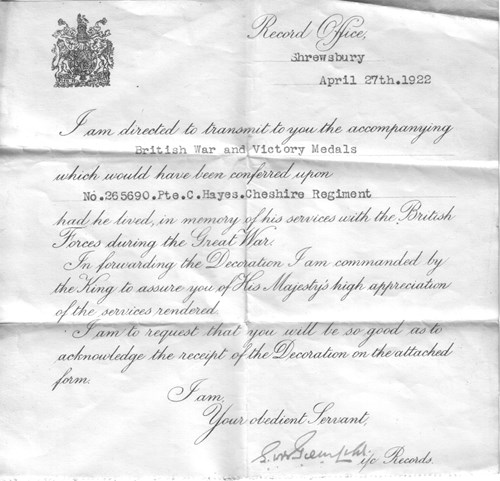
A memorial plaque and scroll was also sent to the widow. This was a separate exercise to the issue of medals. Army form 5080 was sent in 1919 to ascertain the nearest eligible next-of-kin (Figure 35 & Figure 36). The completed form can often be found with soldiers’ service records where these have survived. The scroll (Figure 37) was sent out in a cardboard tube. The plaque (Figure 38) with a cover letter from Buckingham Palace followed sometime later in a stiff cardboard envelope. Although we have the scroll, plaque and enclosed letter for Cornelius Hayes, no correspondence regarding them survives.
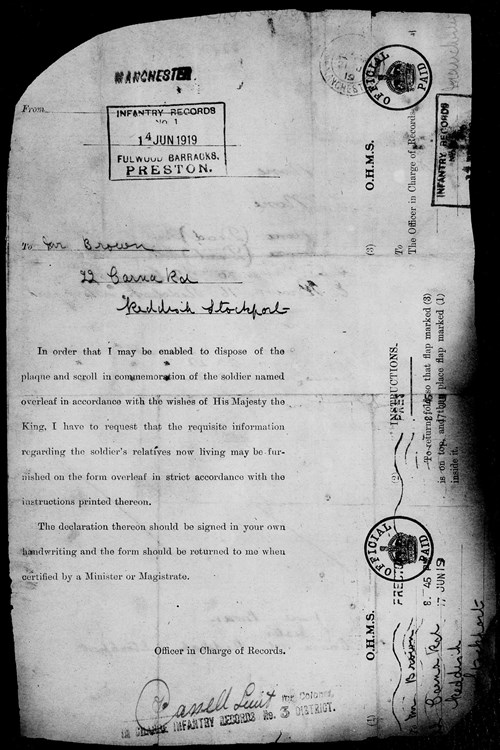
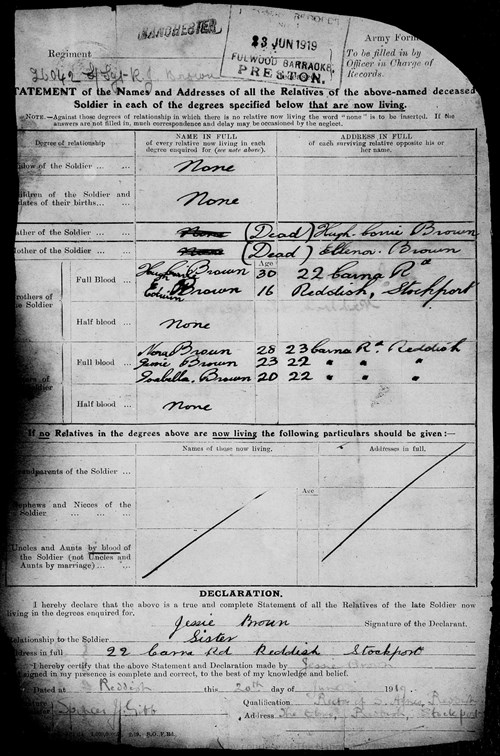
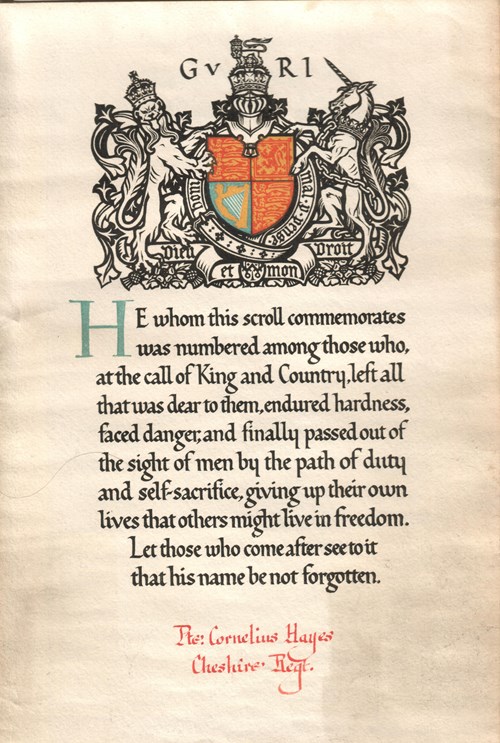
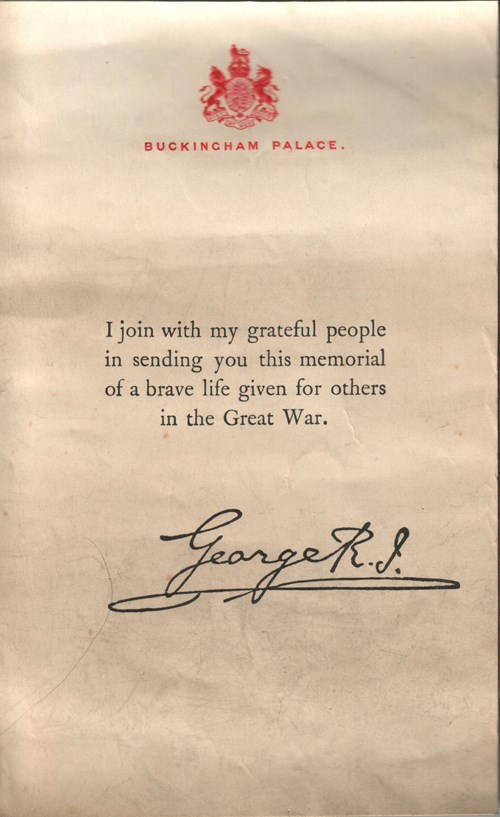
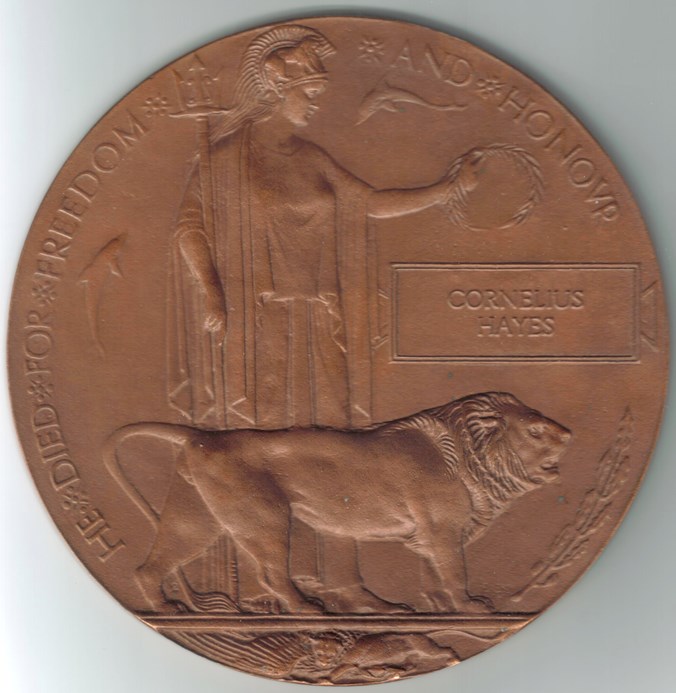
Death Certificate
Death certificates for deceased Great War soldiers are available from the General Register Office. However, they provide no information beyond that easily obtained from other records. In the case of Cornelius Hayes, the death certificate (Figure 39) includes the wrong age and vague places of birth and death, which might lead to difficulty if this was the starting point for research.
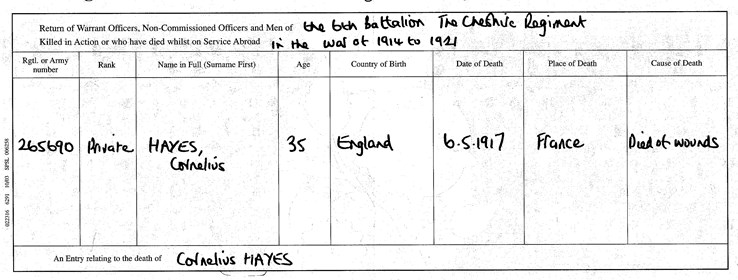
Burial Records
Five months after his death, the family received notification of his burial place on form B104/121 (Figure 40). The Commonwealth War Graves Commission publishes on its website the documents of burials, headstone specifications and inscriptions. Inscriptions were as requested by the deceased next of kin and correspondence was sent out for this purpose and for the entry in the cemetery register. In the case of Cornelius Hayes, this was not returned by the family for reasons unknown and his headstone bears no inscription and the register contains only the bare minimal information.
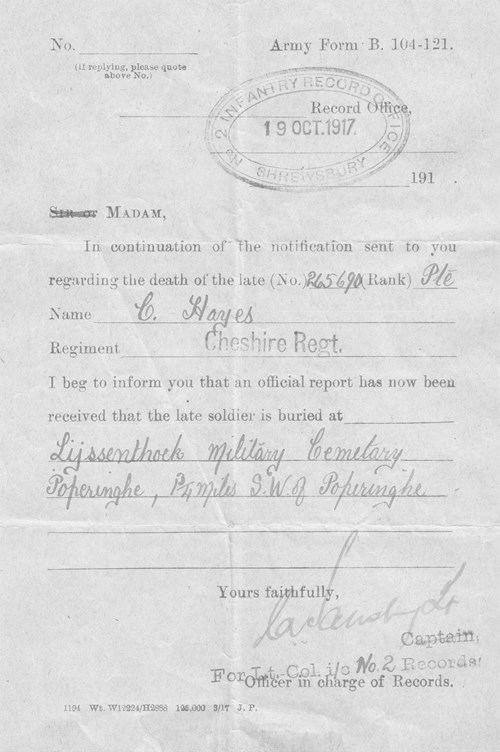
Conclusion
It is hoped that the correspondence illustrated here throws light on a fuller story behind the dry records we use to trace Great War soldiers.
Acknowledgements
My thanks to the Regan, Donohoe and Winstanley families for the loan of and permission to use the items illustrated in this article.
The example of the Pension Card in this article has been extracted from the WFA's Pension Archive. This archive is available to WFA members via the WFA Member Login.
Adam Winstanley (20 January 2019)
Adam Winstanley is a university academic and qualified genealogist.





